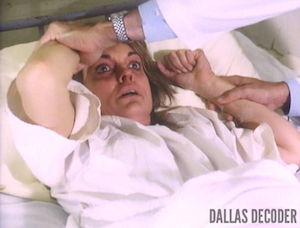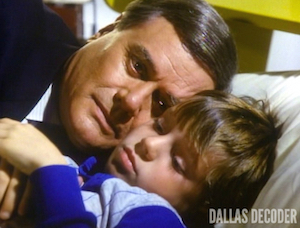
Man of the hour
“Close Encounters,” the 200th hour of “Dallas,” is the kind of episode only this show could produce. Most of the action takes place at a Southfork charity rodeo, where the characters wheel, deal and confront each other over their various romantic entanglements — taking occasional breaks to climb into a saddle and test their calf-roping and barrel-racing skills. Sure, we’ve seen this kind of thing before on “Dallas,” but that doesn’t make it any less fun. If nothing else, “Close Encounters” demonstrates how the Ewings — after almost a decade on the air — had yet to wear out their welcome. Then again, did they ever?
Like the third-season classic “Rodeo,” the only other episode that depicts a Southfork rodeo, “Close Encounters” focuses on J.R. and Sue Ellen’s extramarital inclinations. He spends each episode sneaking around with a mistress (Kristin in “Rodeo,” Mandy in “Close Encounters”), while Sue Ellen finds herself being tempted by Dusty in both installments. The Sue Ellen of 1985 is much smarter and more confident than the 1979 version, however. She dictates the terms of her affair with Dusty in “Close Encounters” (it was the other way around in “Rodeo”), but her progress is also on display during her memorable confrontation with Mandy. In “Close Encounters’” best scene, Sue Ellen pulls the poor, disillusioned young woman aside and warns her that J.R. has a history of mistreating women, but Mandy refuses to listen. Finally, an exasperated Sue Ellen asks, “Isn’t it strange how the mistress always thinks she’s smarter than the wife? If she’s so smart, why is she the mistress?” The line is equal parts wisdom, compassion and bitchiness — and Linda Gray captures each nuance perfectly.
There’s much more to love about “Close Encounters”: Pam and Jenna’s awkwardly poignant exchange, which marks the first time the onetime rivals have seen each other since Bobby’s funeral; Miss Ellie’s “give ’em hell” pep talk to Sue Ellen before the latter participates in the barrel race (you can feel the affection between Gray and Barbara Bel Geddes here); and Angelica Nero’s gigantic, floppy pink hat, which is a look so bold, even Katherine Wentworth wouldn’t have dared it. There’s also the scene where Patricia defends her parenting skills to J.R. “There’s nothing wrong with the way Sue Ellen was brought up,” she says. Larry Hagman waits a beat before delivering J.R.’s retort: “No, just the way she turned out.”
Indeed, more than anything, I get a kick out of watching Hagman in episodes like this. J.R. is all smiles when he’s in the public spotlight at the rodeo, even though he’s privately seething over Patricia’s nosiness, Sue Ellen’s flirtation with Dusty and the fact that Cliff is buzzing around like a gnat, trying to horn in on his dealings with Angelica. And who doesn’t love this episode’s climactic scene, when J.R. — through gritted teeth — announces Dusty has won the coveted belt buckle that designates him as the rodeo’s best all-around cowboy? (Dusty was the winner in “Rodeo” too, although Jock Ewing presented the prize back then.)
“Close Encounters” also brings Ray and Donna’s pregnancy storyline to a close: She suffers a miscarriage after a caged bull causes her to take a spill. The expression on Susan Howard’s face when Donna falls says so much about the character’s fear, while Steve Kanaly does a nice job conveying Ray’s anguish in the hospital scenes. The episode also offers its share of curiosities: Why do the producers show Ray congratulating the taciturn adolescent Rocky on his victory in the rodeo’s junior competition? Is the point to demonstrate that Ray is good with children, thus making Donna’s miscarriage at the end of the episode seem even more tragic? Or was there some subplot involving Rocky that was left on the cutting-room floor? Why is this kid so mopey, after all?
In the same spirit, what should we make of the cameo by Mark White, the real-life Texas governor who appears at the beginning of the rodeo? Besides becoming the first person to play himself on “Dallas” (following appearances by Gerald and Betty Ford and Henry Kissinger in a 1983 “Dynasty” episode), White manages to deliver a hilariously brief speech when he greets the rodeo-goers thusly: “Thank you. Thank you. It’s really great to be with y’all up here today. Thank you.”
A politician who limits his public pronouncements to just 16 words? How did we not know this season was going to turn out to be a dream?
Grade: A
_______________________________________________________________________________________________________________________________________________

Changed woman
‘CLOSE ENCOUNTERS’
Season 9, Episode 9
Airdate: November 15, 1985
Audience: 19.8 million homes, ranking 9th in the weekly ratings
Writer: Hollace White and Stephanie Garman
Director: Corey Allen
Synopsis: Angelica decides to do business with Ewing Oil. Sue Ellen raises Mandy’s doubts about J.R. and resumes her romance with Dusty. Donna suffers a miscarriage after falling at the Ewing Rodeo.
Cast: John Beck (Mark Graison), Barbara Bel Geddes (Miss Ellie Farlow), Barbara Carrera (Angelica Nero), Gino De Mauro (Rocky), Jim Gough (Announcer), Linda Gray (Sue Ellen Ewing), Larry Hagman (J.R. Ewing), Robert Harper (Doctor), Joshua Harris (Christopher Ewing), Jenilee Harrison (Jamie Ewing), Susan Howard (Donna Krebbs), Steve Kanaly (Ray Krebbs), Omri Katz (John Ross Ewing), Howard Keel (Clayton Farlow), Ken Kercheval (Cliff Barnes), Shalane McCall (Charlie Wade), Priscilla Beaulieu Presley (Jenna Wade), Victoria Principal (Pam Ewing), Dack Rambo (Jack Ewing), Deborah Rennard (Sly), Deborah Shelton (Mandy Winger), Merete Van Kamp (Grace), Governor Mark White (Himself)
“Close Encounters” is available on DVD and at Amazon and iTunes. Watch the episode and share your comments below.
































